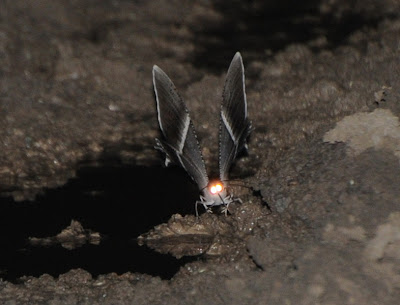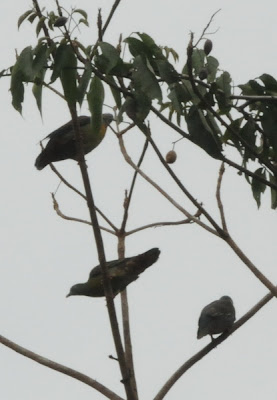Back at Long Peluan, I wanted to see some of the nearby forest. This meant, on January 20, 2012, an arduous (well, for me, not for Isai and my kampung guide) slog to the top of the ridge across the river, where I could look back at the kampung below.
Here we were in (so I was told) unlogged forest. There were certainly some magnificent trees, their trunks rising into the canopy accompanied by attendant vines.
Some of the forest trees bore clusters of brightly-coloured fruits.

On the forest floor we found a wild mangosteen (Garcinia sp.), fallen from a tree above.
A bright red-and-yellow ginger flower, a species of Etlingera, sprouted from an underground stem.
This is a clavarioid, or coral, or club fungus (take your pick - they are all names for the same thing). Not all coral fungi are closely related to each other, apparently - this growth habit has evolved more than once - so the name may not tell us very much.
A trail along the ridge top led to the pristinely-cleared display ground
of a male Great Argus Pheasant (Argusianus argus). We heard his loud wolf-whistle call nearby - he could not have been far off - but never saw the bird itself. From the same spot we heard another near-invisible species,
Blue-banded Pitta (Pitta arcuata).
Not far away, the female of a pair of Red-naped Trogons (Harpactes kasumba) sat quietly on a limb overhead. Note the
blue, not violet, facial skin - that's how we know that this isn't the otherwise-similar Diard's Trogon (H. diardii).
The brilliant male proved a much less cooperative subject.
The brilliant male proved a much less cooperative subject.
An agitated pair of White-necked Babblers (Stachyris leucotis), a new bird for me, simply
wouldn't leave us alone. I can only assume that they had a nest in a
nearby thicket - I could have photographed them all day, and this is
usually a shy bird indeed. The alarm note is a repeated, harsh
"chaak!".
Our walk, in sum, was both stimulating and exhausting. I think this photo demonstrates the latter more than the former!
Back at the longhouse, we gathered for dinner - cooked over the tetel, the traditional hearth, our cook grimacing in the heat.
After sunset I donned my headlamp for a night walk along the road to the kampung. I found no mammals, frogs or night birds, but I did pick up the eye shine of a handsome sphinx moth.
Spider eyeshine is far brighter than their size would lead you to expect, and spiders of various kinds are therefore (perhaps disproportionately) a feature of any forest night walk.
This spectral creature is a common moth, Lyssa zampa, or, possibly, its very similar relative L. menoetius - members of the subfamily Uraniinae, whose members are often brilliantly coloured (though not in Borneo), active by day and mistaken for swallowtail butterflies.
The next morning was our last in the highlands, but before heading back to the airport at Long Banga I only had time for a brief walk, along the same road I had explored the night before. These aren't the best photos, but at the top is a Chestnut-winged Babbler (Stachyris erythroptera) and, below, a party of Little Green Pigeons (Treron olax).
Our walk, in sum, was both stimulating and exhausting. I think this photo demonstrates the latter more than the former!
Back at the longhouse, we gathered for dinner - cooked over the tetel, the traditional hearth, our cook grimacing in the heat.
After sunset I donned my headlamp for a night walk along the road to the kampung. I found no mammals, frogs or night birds, but I did pick up the eye shine of a handsome sphinx moth.
Spider eyeshine is far brighter than their size would lead you to expect, and spiders of various kinds are therefore (perhaps disproportionately) a feature of any forest night walk.
This spectral creature is a common moth, Lyssa zampa, or, possibly, its very similar relative L. menoetius - members of the subfamily Uraniinae, whose members are often brilliantly coloured (though not in Borneo), active by day and mistaken for swallowtail butterflies.
The next morning was our last in the highlands, but before heading back to the airport at Long Banga I only had time for a brief walk, along the same road I had explored the night before. These aren't the best photos, but at the top is a Chestnut-winged Babbler (Stachyris erythroptera) and, below, a party of Little Green Pigeons (Treron olax).
Bulwer's pheasant - bang ngio (male)
Great Argus - ruweh
Red-naped trogon - long
Bushy-crested Hornbill - eang or eng
Rhinoceros Hornbill - menangang
Helmeted Hornbill - manudun
Barbets - pelah
Eurylaimine Broadbills - gelanau
Green broadbills - tukee
Blue-banded Pitta - metai
Asian Paradise Flycatcher - aweh beringing
Greater Racket-tailed Drongo - aweh langan (langan means blowpipe)
Oriental Magpie Robin - beru ngrian
White-necked Babbler - Langiret
Sunbirds - Ngai
Flowerpeckers - ciwit (c is soft)
Dusky Munia - Pirit itam (itam=black)
Chestnut Munia - Pirit sia (sia=red)
Pin-tailed Parrotfinch - tukee tepuh (sugar cane)




























No comments:
Post a Comment